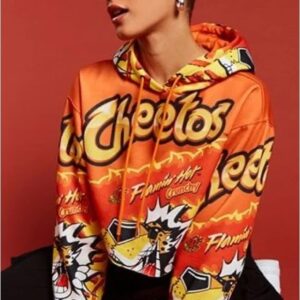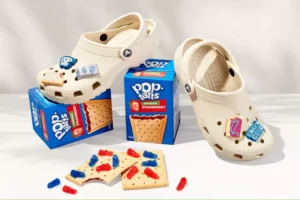by Nikhil Gharekhan, Managing Partner, Presciant
What are unlikely brand partnerships?
Early in 2024, the romance of Taylor Swift and Travis Kelce, stars of music and sports, captured the world’s attention, ignited social media, and spawned conspiracy theories. It also had a material economic impact, attracting a whole new audience to football games, increasing viewership among 18–24-year-olds by 24% and generating an incremental $351M in revenues for the NFL.
This intersection of two very different spheres is only the most visible example of a phenomenon that will continue to grow— the unlikely brand alliance.
Unlikely brand partnerships have always been around
Brand partnerships between apparently incongruent brands are not a new concept.

In 2019, the cheesy snack Cheetos teamed up with the trendsetting brand Forever 21 to launch an apparel collection inspired by the food’s bright colors and cheetah mascot. While the combination brought in a modest $1.24M in revenues, it generated considerable buzz, and is estimated to have captured 550M media impressions and $11M in earned media. In 2016, camera maker Go-Pro and energy drink company Red Bull, launched a multi-year global partnership spanning content production, distribution, cross promotion and product innovation. While seemingly incompatible, the two brands found common ground in their individual brand essences and framed the brand partnership as “inspiring the world to live a bigger life.”
The brand collaboration between the high fashion of Louis Vuitton and the rebellious streetwear of Supreme in 2017 seemed even more unlikely. The 2 companies had been engaged in a decades-long legal tussle, starting with Louis Vuitton issuing a cease-and-desist notice to Supreme in 2000 for its LV-inspired apparel. And yet here they were, setting aside their differences, and launching a much talked about collaboration in a brand partnership that created a new category of fashion, blending elegance with edginess.
Brand partnerships are an accelerating trend
What began as an occasional announcement has now become a cacophony of wild team-ups. The number of unlikely brand partnerships reached unprecedented levels in 2023 and shows no sign of stopping. Enemies are pairing up. Disconnected industries are fusing. No boundary is sacrosanct anymore when it comes to unlikely brand partnerships.
McDonald’s and Krispy Kreme, rivals in breakfast retail, recently announced a major brand partnership in which McDonald’s will sell three varieties of Krispy Kreme donuts in all its locations across the US. McDonald’s had been trying for years to break into the breakfast market, and had launched its own line of baked goods, competing with donut and coffee retailers. Now it has teamed up with a significant competitor, hoping to attract more customers at breakfast time. Krispy Kreme, for its part, gains access to 13,500 retail outlets across the US, compared to its own 400 outlets.
While this unlikely brand alliance makes strategic sense, the world of food is exploding with other outlandish brand collaborations that are clearly intended to raise eyebrows, not necessarily to open wallets. Candy maker Skittles teamed up with French’s Mustard to introduce mustard-flavored sweets. Shades of Harry Potter?

The toasted pastry brand Pop-Tarts took the internet by storm last summer when it partnered with clog maker Crocs and launched Croc-Tarts, a co-branded kit including sandals decorated with pastries and pastries shaped as sandals. Is this what has inspired Jerry Seinfeld to make full-length movie about Pop-Tarts? Stimulated by a scene from the TV show “The Real Housewives of New York City,” the mass brand of potato chips, Pringles, partnered with the upscale The Caviar Co. to create the Crisps and Caviar collection, and even got recommended as “the ultimate high-low marriage” by Food & Wine magazine. Ice-cream brand Ben & Jerry’s worked with Nike to launch a funky looking sneaker. Fast-food brand Arby made a brand partnership with deodorant brand Old Spice to launch the Meat Sweat Defense Kit, including specially designed anti-perspirant sprays and branded towels intended to combat sweat brought on by eating heavy doses of meat.
Unusual brand partnerships are not limited to the world of food. High-end fashion house Dolce & Gabbana collaborated with Smeg, manufacturer of home appliances, to create a line of luxury kitchen appliances, drawing on their common roots of creativity and Italy as their home. Shapewear brand SKIMS partnered with luxury crystal brand Swarovski to launch a new collection. Tiffany and Nike. Chanel and Formula 1. Fendi and Heytea. NASA and Prada. The list goes on.
Unexpected brand collaborations in B2B
In B2B too, unusual brand partnerships are being forged, though mostly in tech, and driven by AI. Amazon Web Services had been dipping its toes in CRM with its Amazon Connect offering. So, its combination with CRM rival Salesforce was unexpected, but is being framed as a powerful integration of AI and data cloud services. Adobe and Microsoft had been rivals historically, fierce competitors in document creation software with regular fights over the use of fonts. But they have now teamed up to integrate Adobe’s new AI generative capabilities with Microsoft’s cloud infrastructure and business solutions.
Why the surge in these unexpected brand partnerships?
Cultural trends and demographic preferences are making conditions ripe for the unusual brand collaborations.
Consumer openness to brand collaboration is extremely high—71% of people say they enjoy brand partnerships more than single brand marketing, according to a recent survey. And search data shows an eleven-fold increase in the term “brand collaborations” in the past 10 years.
GenZ is especially receptive to brand collaboration and fickle in terms of brand loyalty. 81% of GenZs say that brand partnerships can lead them to reconsider a brand they had moved away from.
Another factor is the drop phenomenon, which is at an all-time high and growing. Product drops historically were confined to music—think album launches. They were unused as a marketing tactic. Then, streetwear brands GOODENOUGH in Tokyo and Supreme in New York started doing one-off apparel drops and grew a base of loyal customers. Nowadays, product drops have spread from fashion into food, furniture, software, gaming, and much more. Everywhere you go, you see crowds lined up in the most unexpected places for no obvious reason. They are waiting for a product to drop. What product? Maybe they even don’t know. The same thing used to happen in Soviet Russia, because goods were unavailable.
Brand alliances can add value
It is heartening to see that creativity in marketing is not dead, certainly in the quest for new brand partnerships. Many of the examples above suggest that the benefits are short-term—generate buzz, create scarcity and urgency to buy for consumers or customers. But the right brand collaboration can deliver longer-term concrete advantages to both parties. It can open up new audiences. It can provide access to new distribution channels. It can add desired but missing attributes to a brand’s equity. It can reduce risk and capital investments to enter a new category. It can create marketing efficiency from two brands sharing costs. And, through all this, it can generate incremental financial value.
Marketers should be thoughtful with new brand partnerships
There are significant risks involved too—the wrong brand partnership can destroy brand equity and financial value. The marketing world is going haywire with the bizarre associations it is churning out at a head-spinning rate. Marketers must of course let the creative juices flow but apply some basic filters in their decision-making.
Fortunately, any brand worth its salt already has the tool it needs to evaluate a brand collaboration—the brand positioning. Marketers can use a clearly defined brand purpose, proposition and attributes as a litmus test in picking other brands to associate with. Does the partner brand fit our brand? Will each brand maintain its authenticity if the two are put together? Will the other brand add new attributes that we are seeking?
Clearly defined objectives are the other critical component in a brand partnership. Are we trying to extend our appeal to a new audience? Are we trying to open up a new go-to-market approach? Are we looking for more brand awareness? Or are we trying to change brand perceptions? For each of these objectives, both parties should agree specific metrics.
Unusual brand alliance pairings will continue to delight, surprise and sometimes even disgust us. Let’s not make them desperate shots to create short-term buzz. Properly put together, brand partnerships can fulfil brand’s most important role—creating long-term financial value.